1997 PONTIAC GRAND AM brake
[x] Cancel search: brakePage 6 of 371
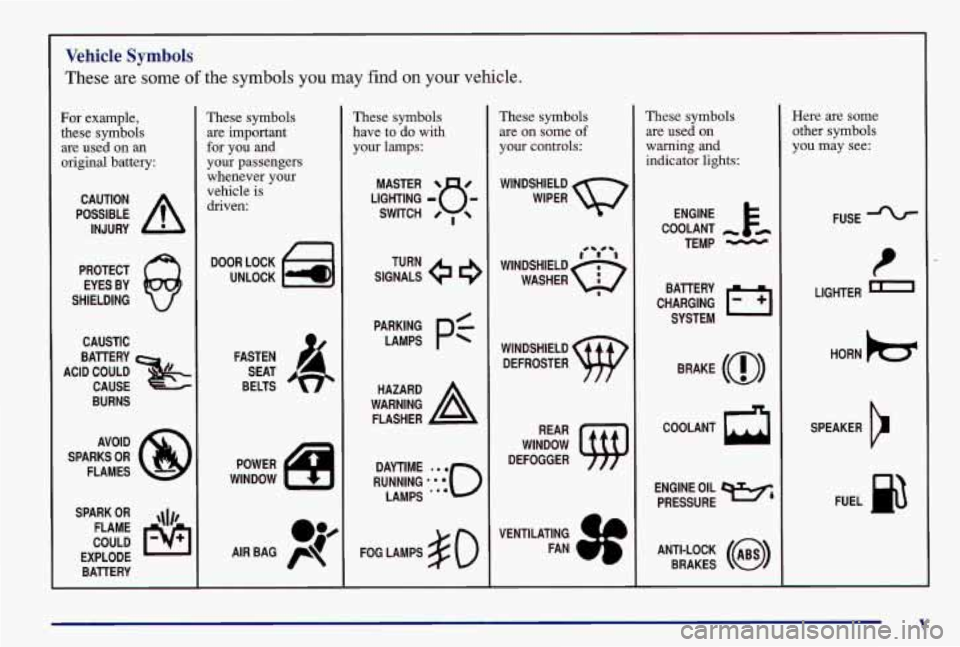
Vehicle Symbols
These are some of the symbols you may find on your vehicle.
For example,
these symbols are used on
an
original battery:
POSSIBLE A
CAUTION
INJURY
PROTECT EYES BY
SHIELDING
CAUSTIC
ACID COULD BATTERY
CAUSE
BURNS
SPARK
OR ,\I/,
COULD FLAME
EXPLODE BA'ITERY
These symbols
are important
for you and
your passengers whenever your
vehicle is
driven:
DOOR LOCK
UNLOCK
FASTEN SEAT
BELTS
These symbols
have to do with
your lamps:
SIGNALS e
TURN
FOG LAMPS
$0
These symbols
are on some
of
your controls:
WINDSHIELD
WIPER
WINDSHIELD DEFROSTER
These symbols
are used
on
warning and
indicator lights:
COOLANT -
TEMP -
CHARGING I-1
BA'ITERY
SYSTEM
BRAKE
(a)
COOLANT a
ENGINE OIL w,
PRESSURE
ANTI-LOCK
(@)
BRAKES
Here are some
other symbols
you may see:
FUSE -%-
t
LIGHTER n
HORN )tr
SPEAKER
b
FUEL m
V
Page 56 of 371
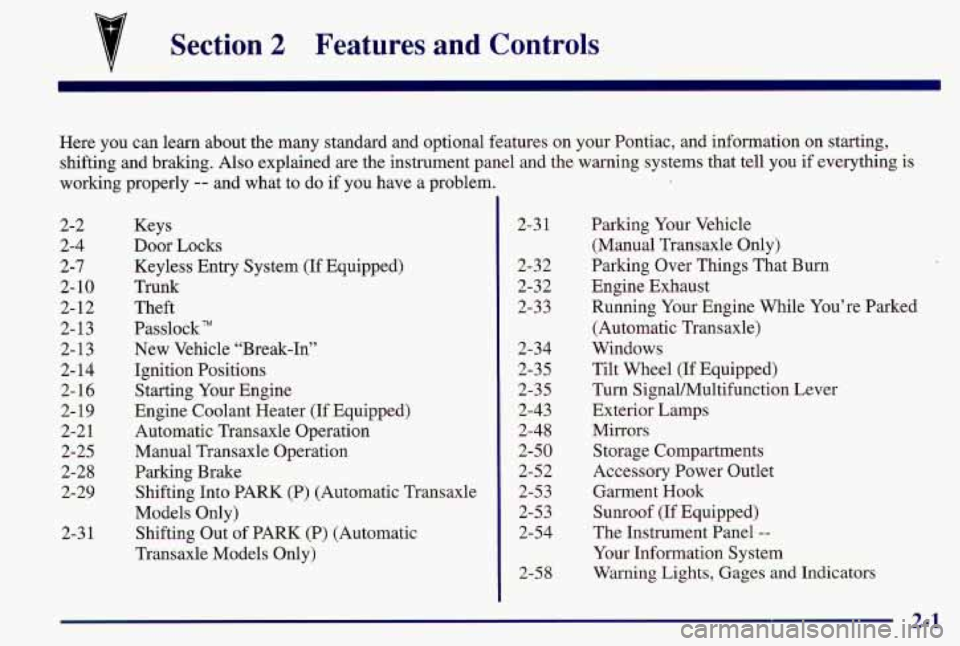
Section 2 Features and Controls
Here you can learn about the many standard and optional features on your Pontiac, and information on starting,
shifting and braking. Also explained are the instrument panel and the warning systems that tell you if everything is
working properly
-- and what to do if you have a problem.
2-2 2-4
2-7
2-
10
2-12 2-13 2-13
2-
14
2- 16
2-19
2-2
1
2-25
2-28
2-29
2-3
1
Keys
Door Locks
Keyless Entry System (If Equipped)
Trunk
Theft
Passlock
TM
New Vehicle “Break-In”
Ignition Positions Starting Your Engine
Engine Coolant Heater (If Equipped)
Automatic Transaxle Operation
Manual Transaxle Operation
Parking Brake Shifting Into PARK (P) (Automatic Transaxle
Models Only) Shifting Out of PARK (P) (Automatic
Transaxle Models Only) 2-3
1
2-32
2-32
2-33
2-34
2-35
2-35 2-43
2-48
2-50
2-52
2-53
2-53
2-54
2-58
Parking Your Vehicle
(Manual Transaxle Only)
Parking Over Things That Burn
Engine Exhaust Running Your Engine While You’re Parked
(Automatic Transaxle)
Windows
Tilt Wheel (If Equipped)
Turn SignaUMultifunction Lever
Exterior Lamps
Mirrors Storage Compartments
Accessory Power Outlet
Garment Hook
Sunroof (If Equipped)
The Instrument Panel
--
Your Information System
Warning Lights, Gages and Indicators
2-1
Page 63 of 371
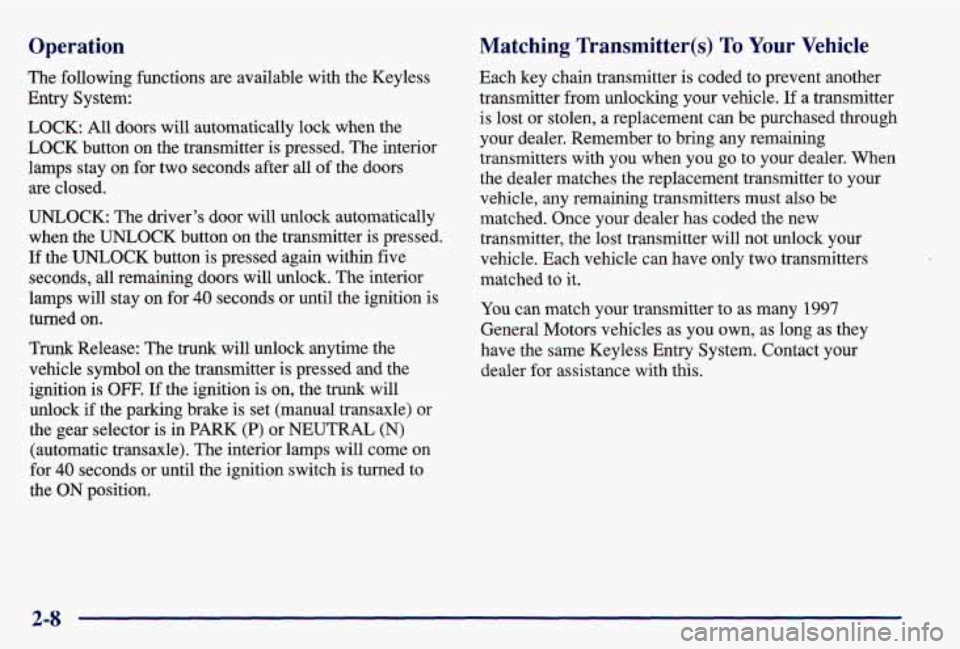
Operation
The following functions are available with the Keyless
Entry System:
LOCK: All doors will automatically lock when the
LOCK button on the transmitter is pressed. The interior
lamps stay on for two seconds after all of the doors
are closed.
UNLOCK: The driver’s door will unlock automatically
when the UNLOCK button on the transmitter is pressed.
If the UNLOCK button is pressed again within five
seconds, all remaining doors will unlock. The interior
lamps will stay on for
40 seconds or until the ignition is
turned on.
Trunk Release: The trunk will unlock anytime the
vehicle symbol
on the transmitter is pressed and the
ignition is
OW. If the ignition is on, the trunk will
unlock
if the parking brake is set (manual transaxle) or
the gear selector
is in PARK (P) or NEUTRAL (N)
(automatic transaxle). The interior lamps will come on
for 40 seconds or until the ignition switch is turned to
the
ON position.
Matching Transmitter(s) To Your Vehicle
Each key chain transmitter is coded to prevent another
transmitter from unlocking your vehicle.
If a transmitter
is lost or stolen, a replacement can be purchased through
your dealer. Remember to bring any remaining
transmitters with you when you go to your dealer. When
the dealer matches the replacement transmitter to your
vehicle, any remaining transmitters must also be
matched. Once your dealer has coded the new
transmitter, the lost transmitter will not unlock your
vehicle. Each vehicle can have only two transmitters
matched to it.
You can match your transmitter to as many 1997
General Motors vehicles as you own, as long as they
have the same Keyless Entry System. Contact your
dealer for assistance with this.
2-8
Page 68 of 371

Passlock TM
Your vehicle is equipped with the Passlock
theft-deterrent system.
Passlock is a passive theft-deterrent system. The system is
armed once the key is removed from the ignition. Passlock
enables fuel if the ignition lock cylinder is turned with a valid key.
If a correct key is not used, fuel is disabled,
During normal operation, the THEFT SYS light will go
off after the engine is started. If the engine stalls and the
THEFT SYS light flashes, wait until the light stops
flashing before trying to restart the engine. Remember to
release the key from the START position as soon as the
engine starts. If you are driving and the THEFT
SYS
light comes on, you will be able to restart the engine if
you turn the engine off. However, your Passlock system
is not working properly and must be serviced by your
dealer. Your vehicle is not protected by Passlock at this
time.
You may also want to check the fuse (see “Fuses
and Circuit Breakers” in the Index). See your Pontiac
dealer for service.
If the THEFT SYS light comes on while the engine is
running,
a problem has been detected and the system
may need service. See your dealer for service.
In an emergency, call the Pontiac Roadside Assistance
Center at 1-800-ROADSIB or 1-800-762-3743.
New Vehicle “Break-InSS
NOTICE:
Your modern Pontiac doesn’t need an elaborate
“break-in,” But it will perform better in the long
run
if you follow these guidelines:
0
0
0
Don’t drive at any one speed -- fast or
slow
-- for the first 500 miles (805 km).
Don’t make full-throttle starts,
Avoid making hard stops for the first
200 miles (322 km) or so, During this time
your new brake linings aren’t yet broken
in. Hard stops with new linings can mean
premature wear and earlier replacement.
Follow this breaking-in guideline every
time you get new brake linings,
Don’t tow
a trailer during break-in,
See “Towing a Trailer” in the Index for
more information.
2-13
Page 76 of 371
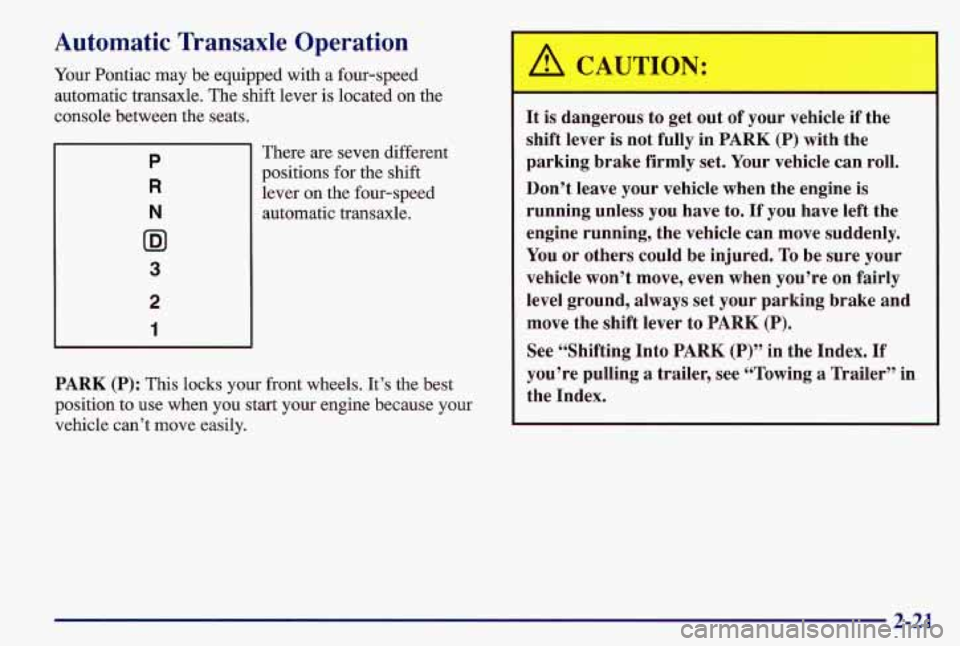
Automatic Transaxle Operation
Your Pontiac may be equipped with a four-speed
automatic transaxle. The shift lever is located on the
console between the seats.
There are seven different
positions for the shift
lever
on the four-speed
N
[Dl
3
automatic transaxle.
PARK (P): This locks your front wheels. It’s the best
position
to use when you start your engine because your
vehicle can’t move easily.
A CAUTION:
It is dangerous to get out of your vehicle if the
shift lever is not fully in
PARK (P) with the
parking brake firmly set. Your vehicle can roll.
Don’t leave your vehicle when the engine
is
running unless you have to. If you have left the
engine running, the vehicle can move suddenly.
You or others could be injured. To be sure your
vehicle won’t move, even when you’re on fairly
level ground, always set your parking brake and
move the shift lever to
PARK (P).
See “Shifting Into PARK (P)” in the Index. If
you’re pulling a trailer, see “Towing a Trailer’’ in
the Index.
2-21
Page 77 of 371

Ensure the shift lever is fully in PARK (P) range before
starting the engine. Your Pontiac has a brake-transaxle
shift interlock. You have to fully apply your regular
brakes before you can shift from PARK
(P) when the
ignition key is in the
RUN position. If you cannot shift
out
of PARK (P), ease pressure on the shift lever -- push
the shift lever all the way into PARK (P)
-- as you
maintain brake application. Then move the shift lever into the gear you wish. (Press the shift lever button
before moving the shift lever.) See “Shifting Out
of
PARK (P)” later in this section.
REVERSE (R): Use this gear to back up.
I NOTICE:
~~
1
Shifting to REVERSE (R) while your vehicle is
moving forward could damage your transaxle.
Shift to
REVERSE (R) only after your vehicle
is stopped.
1
To rock your vehicle back and forth to get out of snow,
ice or sand without damaging your transaxle, see
“If
You’re Stuck: In Sand, Mud, Ice or Snow” in the Index.
NEUTRAL (N): In this position, your engine
doesn’t connect with the wheels.
To restart when you’re
already moving, use NEUTRAL
(N) only. Also, use
NEUTRAL
(N) when your vehicle is being towed.
I
Shifting out of PARK (P) or NEUTRAL (N) while
your engine
is “racing” (running at high speed) is
dangerous. Unless your foot is firmly on the
brake pedal, your vehicle could move very
rapidly. You could lose control and hit people or
objects. Don’t shift out
of PARK (P) or
NEUTRAL (N) while your engine is racing.
NOTICE:
Damage to your transaxle caused by shifting out
of
PARK (P) or NEUTRAL (N) with the engine
racing isn’t covered by your warranty.
r
2-22
Page 79 of 371

SECOND (2): This position gives you more power but
lower fuel economy. You can use SECOND
(2) on hills.
It can help control your speed as you go down steep
mountain roads, but then you would also want to use
your brakes off and
on.
NOTICE:
Don’t drive in SECOND (2) for more than
25 miles (41 km), or at speeds over 55 mph
(88 km/h), or you can damage your transaxle.
Use AUTOMATIC OVERDRIVE
(@) or
THIRD
(3) as much as possible. Don’t shift into
SECOND
(2) unless you are going slower than
65 mph (105 km/h) or you can damage
your engine.
With automatic overdrive, SECOND
(2) will select
either first or second gear depending on vehicle speed.
If
your vehicle is slowing, the transaxle will downshift to
first gear at
20 to 25 miles per hour (32 to 40 km/h) for
engine braking. You may notice some variation in shift
speed in SECOND
(2) when accelerating or braking. FIRST
(1): This position gives
you even more power
(but lower fuel economy) than SECOND
(2). You can
use it on very steep hills, or in deep snow or mud.
If the
selector lever is put in
FIRST (l), the transaxle won’t
shift into first gear until the vehicle is going slowly
enough.
I NOTICE: 1
If your front wheels can’t rotate, don’t try to
drive. This might happen if you were stuck in
very deep sand or mud or were up against
a solid
object.
You can damage your transaxle.
~ Also, if you stop when going uphill, don’t hold
your vehicle there with only the accelerator
pedal. This could overheat and damage the
transaxle. Use your brakes or shift into PARK
(P)
to hold your vehicle in position on a hill.
2-24
Page 80 of 371
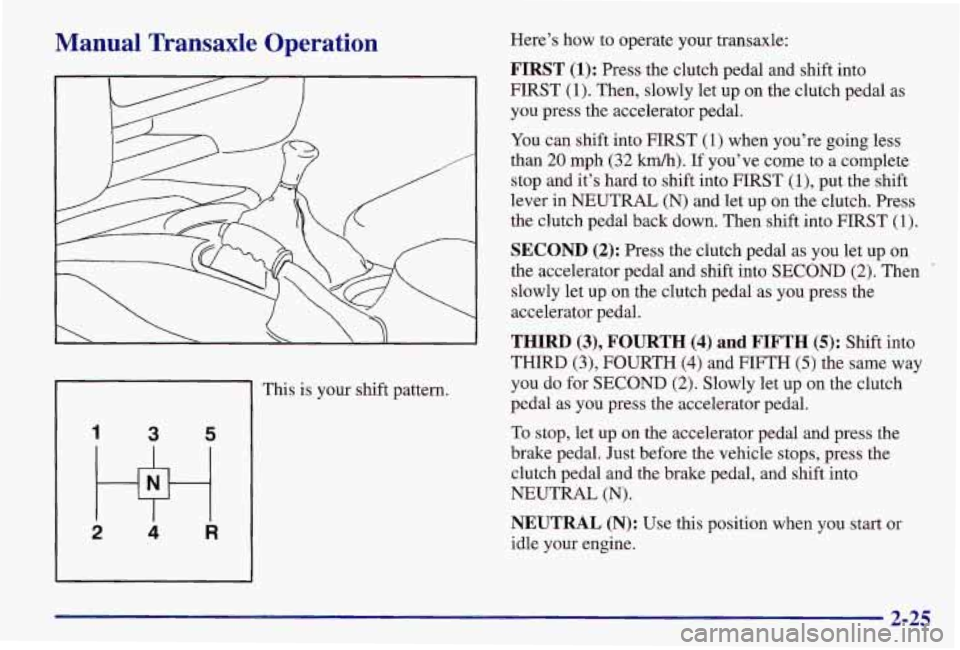
Manual Transaxle Operation
1 3 5
2 w 4 R
This is your shift pattern. Here’s how
to operate your transaxle:
FIRST (1): Press the clutch pedal and shift into
FIRST
(1). Then, slowly let up on the clutch pedal as
you press the accelerator pedal.
You can shift into FIRST
(1) when you’re going less
than
20 mph (32 km/h). If you’ve come to a complete
stop and it’s hard to shift into FIRST
(l), put the shift
lever in NEUTRAL (N) and let up on the clutch. Press
the clutch pedal back down. Then shift into FIRST
(1).
SECOND (2): Press the clutch pedal as you let up on
the accelerator pedal and shift into
SECOND (2). Then
slowly let up on the clutch pedal as you press the
accelerator pedal.
THIRD (3), FOURTH (4) and FIFTH (5): Shift into
THIRD (3), FOURTH
(4) and FIFTH (5) the same way
you do for
SECOND (2). Slowly let up on the clutch
pedal as you press the accelerator pedal.
To stop, let up on the accelerator pedal and press the
brake pedal. Just before the vehicle stops, press the clutch pedal and the brake pedal, and shift into
NEUTRAL
(N).
NEUTRAL (N): Use this position when you start or
idle your engine.
2-25